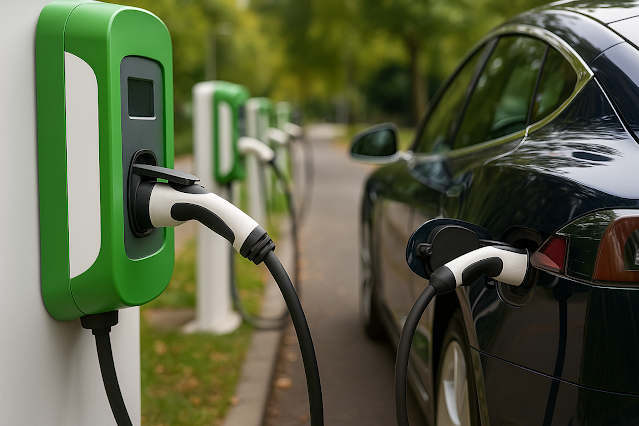1. Components of EV Charging Infrastructure
The EV charging ecosystem consists of several core components:
a) Electric Vehicle Supply Equipment (EVSE)
-
Connects the EV to the electrical source.
-
Can be wall-mounted or free-standing.
b) Power Source
-
May come from the utility grid, solar PV systems, or local storage.
c) Communication Network
-
Facilitates data exchange between the EVSE, EV, and central control systems.
-
Used for billing, monitoring, load management, and fault diagnostics.
d) Energy Management System (EMS)
-
Optimizes power usage, integrates with renewables, and prevents grid overload.
2. EV Charging Levels and Types
EV chargers are categorized by power level, current type, and speed:
| Level | Voltage | Power Range | Charging Time | Application |
|---|---|---|---|---|
| Level 1 | 120V AC | 1.4–1.9 kW | 8–20 hours | Residential |
| Level 2 | 208–240V AC | 3.3–22 kW | 4–8 hours | Residential, Public |
| Level 3 | 400–900V DC | 50–350 kW+ | 15–60 minutes | Highway, Commercial |
3. Charging Standards
Charging standards ensure compatibility and safety between vehicles and charging infrastructure.
a) Connector Standards
-
CCS (Combined Charging System) – Widely used in Europe and North America.
-
CHAdeMO – Popular in Japan and some Asian countries.
-
GB/T – Chinese national standard.
-
Tesla Supercharger – Proprietary, now partially open.
b) Communication Protocols
-
ISO 15118: Enables Plug & Charge, smart charging, and bidirectional power flow.
-
OCPP (Open Charge Point Protocol): Open standard for charger-to-network communication.
-
IEC 61851: General EV conductive charging standard.
4. Design Considerations for EV Charging Infrastructure
A well-engineered charging system must consider technical, economic, and spatial aspects.
a) Site Assessment
-
Traffic flow, parking layout, electrical availability.
-
Future scalability.
b) Power Requirements
-
Total peak demand based on charger type and number.
-
Load calculation considering diversity and simultaneity factors.
c) Load Management
-
Use of Load Balancing, Dynamic Power Allocation, and Time-of-Use Pricing.
-
Implementation of Vehicle-to-Grid (V2G) and Battery Storage to offset peaks.
d) Safety and Protection
-
Ground fault protection, overcurrent devices, surge protection.
-
Compliance with National Electrical Code (NEC) or equivalent.
5. Grid Impact of EV Charging
The integration of EV chargers into the power grid poses both challenges and opportunities.
a) Challenges
-
Increased Peak Load: High concentration of fast chargers can strain local transformers.
-
Voltage Fluctuations: Especially in weak or rural grids.
-
Harmonics: Introduced by power electronics.
b) Mitigation Strategies
-
Smart Charging: Schedule charging based on grid conditions.
-
Demand Response Integration: EVs participate in grid load regulation.
-
On-site Renewable Energy: Reduces reliance on the grid.
c) Opportunities
-
Grid Services: EVs can act as distributed energy storage (V2G).
-
Renewables Balancing: Charge when solar or wind generation is high.
6. Case Study: Urban EV Charging Station Design
Assumptions:
-
10 Level-2 chargers at a commercial complex.
-
Power requirement per charger: 7.2 kW.
-
Diversity factor: 0.7.
Total Load Calculation:
Design Aspects:
-
Transformer Sizing: 63 kVA with 20% buffer.
-
Cable Sizing: Copper conductors with appropriate insulation for current and voltage drop.
-
EMS Integration: Monitor usage and enable smart scheduling.
7. Future Trends
-
Ultra-Fast Charging: 350–500 kW DC for sub-10 minute full charges.
-
Wireless (Inductive) Charging: Embedded in parking spaces or roads.
-
Bidirectional Charging (V2X): Support for V2G, V2H, and V2B models.
-
AI-Powered EMS: Predictive analytics for optimal load and energy flow control.
FAQs
❓ What is the difference between Level 1, 2, and 3 charging?
-
Level 1: 120V AC, slowest; suitable for overnight home charging.
-
Level 2: 240V AC, common in homes and public stations.
-
Level 3 (DC Fast Charging): High-speed charging using direct current.
❓ What is Plug & Charge?
It’s a feature enabled by ISO 15118 that allows automatic authentication and billing as soon as the EV is plugged into a compatible charger.
❓ How does EV charging affect the power grid?
EVs can significantly increase load demand, potentially overloading transformers, especially during peak hours. Proper load management and distributed energy systems can mitigate this.
❓ What is Vehicle-to-Grid (V2G)?
V2G allows EVs to discharge electricity back to the grid, supporting peak shaving, frequency regulation, and energy arbitrage.
❓ Can solar energy be used to power EV chargers?
Yes. Solar-powered EV stations with battery storage help reduce grid dependency and improve sustainability.
Conclusion
Electric Vehicle Charging Infrastructure is a linchpin for widespread EV adoption. Its design demands careful consideration of power requirements, standards compliance, and grid interaction. With smart technologies and renewable integration, EV charging can evolve from a burden to a valuable asset for grid stability and clean energy transition.

